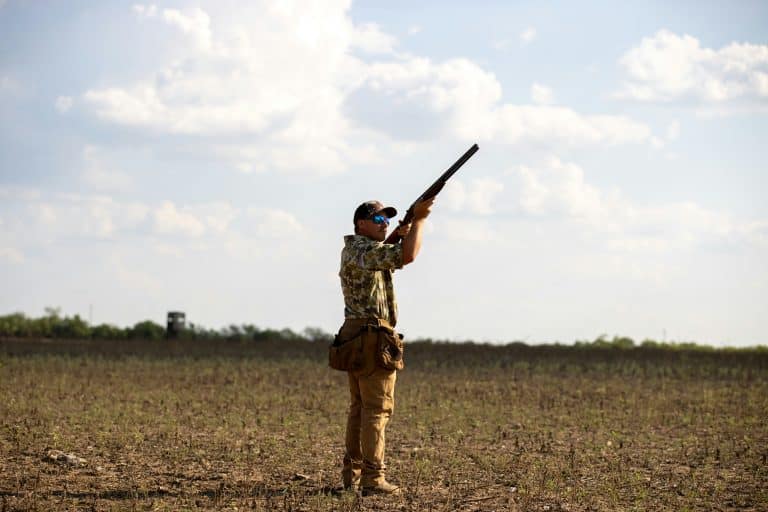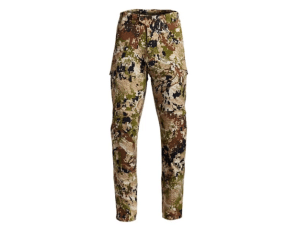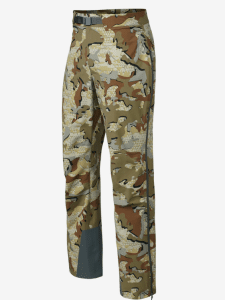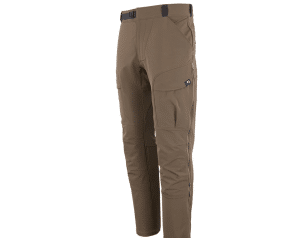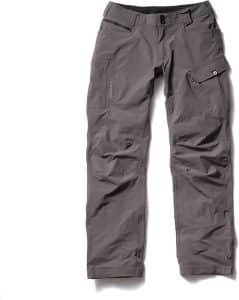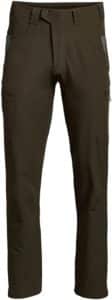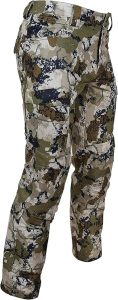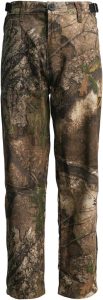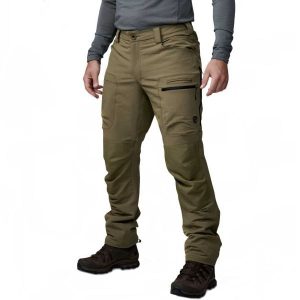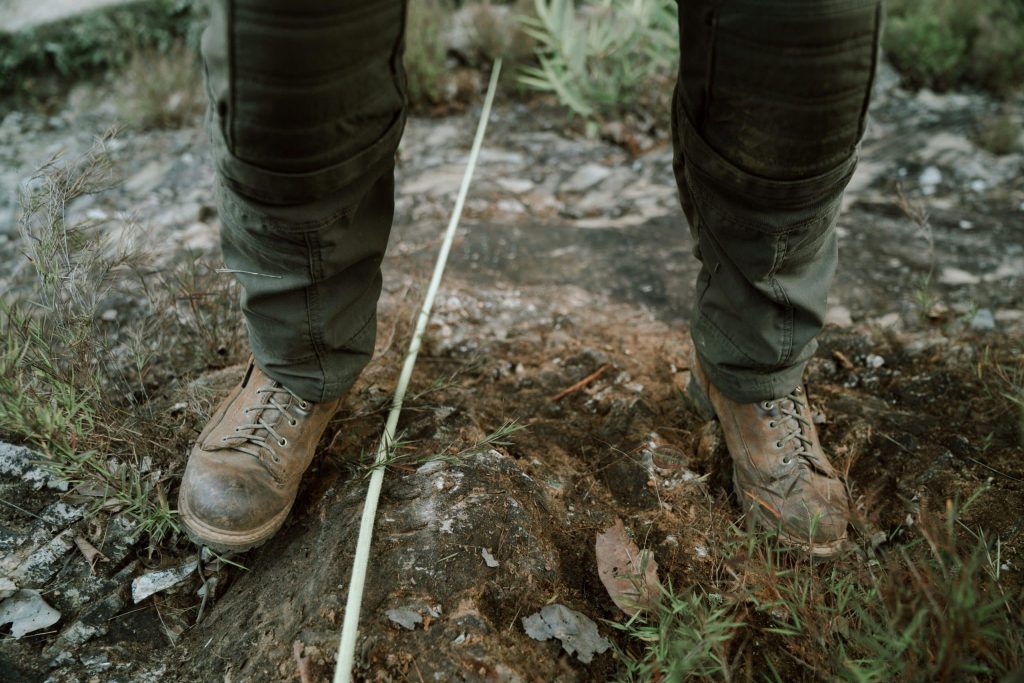After decades of chasing whitetails through thick brush and stalking elk across rocky terrain, I’ve learned that your pants can make or break a hunt. You need gear that won’t tear when you’re crawling through deadfall, stays quiet when that buck finally steps into range, and keeps you comfortable during those long sits in the stand.
I’ve tested dozens of hunting pants over the years — from budget options that fell apart after one season to premium pairs that are still going strong. What I’ve found is that the best hunting pants for men need to balance durability, comfort, weather protection, and stealth. It’s not just about having deep pockets (though that helps when you’re carrying calls and gear).
The pants I’m covering here have all been through real-world testing in various hunting conditions. Some excel in cold weather, others shine in wet conditions, and a few manage to do it all while staying lightweight enough for long hikes. Here’s what actually works when you’re serious about filling tags.
1. Best Overall Hunting Pants: Sitka Intercept Pants
Pros:
- ArmorSpun Merino wool provides excellent odor control for extended hunts
- Removable D3O knee pads offer superior protection during crawling and stalking
- Silent mesh cargo pockets won’t spook game during critical moments
- Side zippers allow quick temperature regulation without removing boots
- Bonded construction increases durability over standard merino
Cons:
- Not water resistant, limiting use in wet conditions
- Premium price point may not fit every hunter’s budget
- Merino blend requires more careful washing than synthetic alternatives
- Knee pads add bulk that some hunters find restrictive
The Sitka Intercept pants have become my go-to choice for most hunting situations, and there’s a good reason why. That ArmorSpun Merino wool construction isn’t just marketing fluff — it genuinely keeps you from stinking up your hunting area even after multiple days in the field. I’ve worn these for week-long elk hunts without washing them, and they still passed the sniff test.
The removable knee pads were skeptical at first, thinking they’d be bulky and awkward, but they’ve saved my knees countless times when stalking through rocky terrain or setting up ground blinds. Those side zippers are brilliant for temperature control — you can dump heat quickly when hiking to your stand, then zip back up when you’re settled in. The silent cargo pockets actually live up to their name, unlike some hunting pants where every movement sounds like you’re unwrapping a candy bar. My main gripe is the lack of water resistance, which means you’ll need rain gear in wet conditions, and at $300, they’re definitely an investment piece.
2. Best Waterproof Pants: KUIU Chugach Rain Pants
Pros:
- Torain waterproof technology provides reliable protection in heavy rain
- 20% lighter than previous version while maintaining durability
- Full-length side zippers allow easy on/off over boots
- 4-way stretch material moves naturally during stalking
- Packs down small for backcountry hunts
Cons:
- Primarily designed as rain gear, not ideal for all-day wear
- Can be noisy when vegetation brushes against the fabric
- Limited breathability during high-exertion activities
- Higher price point for specialized rain gear
When the weather turns nasty, the KUIU Chugach pants are what I reach for. I’ve been caught in downpours that would soak through most “water-resistant” hunting pants, and these kept me completely dry. The upgrade to Torain technology made a real difference — they’re noticeably lighter than the older version, which matters when you’re already carrying a heavy pack. Those full-length side zippers are a game-changer for getting them on and off over hunting boots without having to sit down in the mud.
The 4-way stretch means you’re not fighting the fabric when you need to move quietly through thick cover. What I appreciate most is how small they pack down — they take up minimal space in your pack until you actually need them. The downside is they’re really meant for rain protection, not as your primary hunting pant. They can get a bit clammy during high-activity periods, and they do make some noise when brush scrapes against them. For pure waterproof protection though, they’re hard to beat.
3. Best Cold Weather Hunting Pants: Stone Glacier De Havilland Pants
Pros:
- Contour Waist System allows 3-inch adjustment for layering flexibility
- 4-way stretch fabric provides unrestricted movement in cold conditions
- DWR treatment offers water and wind resistance
- Extra-large side zips provide ventilation options
- Made in USA with quality construction
Cons:
- Heavier than lightweight alternatives at 1.5 pounds
- Higher price point for insulated hunting pants
- May be too warm for early season or mild weather hunts
- Limited color options compared to other brands
The Stone Glacier De Havilland pants are my choice when temperatures drop and the best cold weather hunting pants need to perform. That Contour Waist System isn’t just a fancy feature — it actually works. You can layer heavy base layers underneath and still get a proper fit, then adjust back down when you’re hiking hard and want to shed a layer. I’ve used these on late-season deer hunts where morning temperatures were in the teens, and they kept me comfortable without feeling bulky.
The 4-way stretch is noticeable when you’re climbing over fences or getting into awkward shooting positions. The DWR treatment handles light snow and moisture well, though they’re not truly waterproof. Those large side zips are essential for temperature regulation — you can dump a lot of heat quickly when you’re hiking to your stand. The weight is my main concern at 1.5 pounds, which is definitely noticeable on long hikes.
They’re also pretty warm, so they’re really meant for cold weather hunting, not something you’d want to wear during early bow season. The price reflects the quality construction, and being made in the USA is a nice bonus.
4. Best Lightweight Hunting Pants: TRUEWERK T1
Pros:
- 4-way stretch with reinforced construction handles demanding terrain
- 8 utility pockets provide ample storage for hunting gear
- Moisture-wicking interior keeps you dry during active hunts
- Affordable price point for quality construction
- Machine washable without special care requirements
Cons:
- Work pants design lacks hunting-specific features like scent control
- May not be quiet enough for bow hunting situations
- Limited weather protection compared to hunting-specific brands
- Colors may be too bright for serious hunting applications
The TRUEWERK T1 pants might seem like an odd choice for hunting, being designed as work pants, but hear me out. Sometimes the best deer hunting pants come from unexpected places. These have become my go-to for early-season bow hunting and any situation where I need maximum mobility without breaking the bank.
That 4-way stretch actually outperforms some hunting-specific pants I’ve tried, and the gusseted crotch means you won’t blow them out when climbing into your stand. Eight pockets might sound like overkill, but when you’re carrying calls, rangefinder, spare releases, and all the other gear we accumulate, you’ll use them all. The moisture-wicking interior has kept me comfortable during those sweaty September sits when it’s still 80 degrees but you need full coverage for mosquitoes. They wash easily without any special care, which is refreshing after dealing with merino wool requirements.
The downsides are what you’d expect from work pants — they don’t have scent control technology, they’re not particularly quiet when moving through brush, and the colors aren’t ideal for hunting. For the price though, especially for hunters just getting started or as backup pants, they’re tough to beat.
5. Most Versatile: SITKA Gear Men’s Traverse Pants
Pros:
- 90% recycled polyester construction offers environmental benefits and performance
- Ultra-lightweight design perfect for warm weather and early season hunts
- DWR finish sheds moisture from morning dew and light rain
- Reinforced knife overlay on hand pocket prevents wear from everyday carry
- Multiple secure storage options including zippered seat and leg pockets
Cons:
- Hand wash only requirement
- Limited insulation makes them unsuitable for cold weather hunting
- Lightweight construction may not withstand heavy brush and thorns
- Higher price point for what’s essentially a warm weather pant
The SITKA Traverse pants have earned their spot as my most versatile hunting pants because they handle so many different situations well. I’ve worn these for everything from early season bow hunting to spring turkey season, and they adapt to whatever you throw at them. That recycled polyester fabric isn’t just good for the environment — it actually performs better than I expected, wicking moisture away during those hot September sits while still being quiet enough for bow range encounters.
The DWR finish has saved me more times than I can count when walking through dew-soaked grass or dealing with light drizzle. Those zippered pockets are genuinely secure — I’ve never lost gear from them, even during long hikes or when crawling under fences. The reinforced knife overlay is a nice touch that shows SITKA actually thinks about how hunters use their gear.
My biggest gripe is the hand wash requirement, which is impractical for serious hunting use. They’re also definitely warm weather pants — once temperatures drop below 50 degrees, you’ll need something warmer. For three-season hunting though, these are hard to beat.
6. Best for Active Hunting: King’s Camo XKG Preacher Pant
Pros:
-
4-Way Stretch Fabric – The pant uses a 4-way stretch polyester fabric, which allows freedom of movement across all directions.
-
Removable Knee Pads – Articulated knees with removable knee pads offer protection when crawling or kneeling, which is a major plus for rugged hunts.
-
Ventilation & Temperature Control – Side zippered mesh vents (hip vents) let you dump heat when you’re working hard, or lock in warmth when things cool down.
-
Odor Control Technology – Treated with Polygiene® odor control, helping reduce human scent and keep you more stealthy in the field.
-
Quiet & Durable Construction – Built to be ultra-quiet (important for stalking game) and durable enough for rough terrain (rocks, brush, etc).
Cons:
-
Price Point – Given the specialized features and brand, the cost is relatively high compared to generic hunting pants. (While not explicitly listed in all sources, it’s implied by premium features and niche use.)
-
Potential Over-Feature for Mild Hunts – If you’re doing light terrain, casual hunts, or less demanding conditions, many of the “extreme terrain” features (knee pads, full vents, odor tech) might be overkill and add complexity or bulk
When you’re doing a high-output hunt — think long glassing sessions, steep terrain, stalks, climbing, changing temperatures — you need gear that supports movement, stealth, durability and comfort all at once. The Preacher Pant delivers on all of those. The 4-way stretch means you’re not restricted when hiking, scrambling or dropping to your knees. The removable knee pads show the brand designed it for serious conditions (rocks, brush, crawling) rather than just walking. The vents give you active cooling during exertion, and the odor control helps you stay undetected. Combined, these features make the Preacher Pant ideal for the “active hunter” model: not just sitting in a blind, but moving, adjusting, adapting. For hunts where you’re not just waiting — you’re going — this pant brings the functionality and ruggedness needed.
I’ve worn them on elk hunts where we covered 10+ miles a day, and they never felt restrictive or binding. Those thigh zip vents are brilliant for temperature control — you can dump heat quickly when you’re hiking hard, then zip them up when you settle in for a long sit. The treestand-compatible pockets are a thoughtful design element that actually matters if you spend time in elevated blinds or stands.
The straight leg cut works perfectly with hunting boots and doesn’t bunch up inside your boots like some tapered designs. At $169, they’re definitely an investment, and the polyester means you’ll need to be more careful about scent control than with merino options. They’re also not the best choice for sitting still in cold weather, but for active hunting in moderate temperatures, they’re excellent.
7. Best Youth Option: Scent Blocker Shield Series
Pros:
- Affordable price point makes quality hunting gear accessible
- S3 scent control technology helps reduce odor detection
- Cotton-poly blend offers durability and comfort for the price
- Machine washable for easy care and maintenance
- Four-pocket design provides adequate storage for essential gear
Cons:
- Youth sizing limits options for adult hunters
- Cotton blend may not dry as quickly as synthetic alternatives
- Limited weather resistance compared to technical hunting fabrics
- Basic construction may not withstand extreme hunting conditions
I’ll be honest — I included the Scent Blocker Shield Series primarily because it represents what’s available at the budget end of the hunting pants market, and the youth sizing obviously limits its appeal for most adult hunters. That said, for hunters just getting started or parents outfitting young hunters, it shows what’s possible at the $40 price point.
The S3 scent control technology actually works reasonably well for the price, though it’s not going to compete with premium merino wool or advanced synthetic treatments. The cotton-poly blend is comfortable and durable enough for casual hunting situations, and being machine washable is a real advantage over high-maintenance technical fabrics. The four-pocket design covers the basics without being overwhelming.
Where these pants fall short is in weather protection and advanced features — they’re really meant for fair-weather hunting and won’t handle wet conditions or extreme temperatures. The construction is adequate but not impressive, so don’t expect them to last through years of hard use. For budget-conscious hunters or kids, these can make a great gift.
8. Best Durability: Born Primitive Hunting Pants
Pros:
- Ballistic nylon reinforcement on the seat and knees provides exceptional durability
- Nine-pocket system offers extensive storage for hunting gear
- Ventilated side leg zippers allow temperature regulation without removing boots
- 60% nylon construction with built-in stretch balances toughness and flexibility
- Field-tested design from outdoor expert Aron Snyder adds credibility
Cons:
- Heavy construction may be overkill for lightweight hunting applications
- A complex pocket system could be noisy during critical hunting moments
- Higher nylon content may retain odors more than natural fiber alternatives
- Price point reflects the extensive feature set and construction quality
The Born Primitive Hunting Pants live up to their durability claims better than almost anything else I’ve tested. Those ballistic nylon reinforcements on the seat and knees aren’t just for show — I’ve crawled through rocky terrain, slid down steep slopes, and pushed through thick brush without any signs of wear after multiple seasons. The nine-pocket system is genuinely useful if you carry a lot of gear, though it does add complexity and potential noise issues.
I particularly like the coin pocket design and the variety of pocket access options — it’s clear someone who actually hunts designed these. The ventilated leg zippers are well-placed and effective for temperature control. The 60% nylon construction creates a pant that’s tough as nails while still moving naturally. My main concerns are the weight — these aren’t the pants you want for long hikes — and the potential for noise from all those pockets and zippers.
The nylon construction also means you need to be more aggressive about scent control. For hunters who are hard on their gear or hunt in particularly rough terrain, the durability is worth the tradeoffs. They’re built like armor, which is exactly what some hunting situations require.
9. Best Hunting Pants Brand: Pnuma Outdoors
Pnuma Outdoors has a vast, cost effective, perfect collection of hunting pants. From light and mobile to cold and thermal, they have quiet, rainproof, hunting pants like the top brands but at a much more affordable price. If just looking for a brand to shop, Pnuma Outdoors is the go to brand. Personally, if looking for hunting pants with knee pads, the Pursuit Pant is a top hunting pant. If looking for durable hunting pants, I recommend all of them.
What to Consider When Choosing the Best Hunting Pants
After testing dozens of hunting pants across every type of terrain and weather condition, I’ve learned that the right pair can make the difference between a successful hunt and a miserable day in the field. The pants I’ve recommended here all passed real-world tests — from crawling through briars chasing spring gobblers to sitting motionless in sub-freezing temperatures waiting for that perfect shot.
When I evaluate hunting pants, I look at how they perform in the specific situations hunters actually face. It’s not about having the most features or the flashiest technology — it’s about finding pants that work when everything’s on the line.
Durability and Reinforcements
The best pants for hunting need to handle abuse that would destroy regular clothing. I’ve learned this the hard way after blowing out knees on cheap pants while crawling through rocky terrain. That’s why the Born Primitive pants made my list — those ballistic nylon reinforcements on the seat and knees aren’t just marketing gimmicks. They actually prevent the wear patterns that kill most hunting pants.
Reinforcements matter most in high-wear areas: knees, seat, and inner thighs. The Stone Glacier De Havilland pants use strategic reinforcement without adding unnecessary bulk, while the SITKA Intercept pants rely on their ArmorSpun merino construction for durability. Look for double-stitching in stress areas and consider how the reinforcement material will affect noise levels and flexibility.
I’ve found that pants with good reinforcements typically last three to four times longer than the more basic stuff. When you’re spending $150-300 on hunting pants, durability becomes a key factor in long-term value.
Weather Resistance and Insulation
Temperature management can make or break a hunt, which is why I test pants across different weather conditions. The KUIU Chugach Rain Pants earn their spot as my waterproof choice because they actually keep you dry in sustained downpours — something many “waterproof” pants fail at.
For insulation, think about your typical hunting conditions. The Stone Glacier De Havilland pants work well for cold weather hunting, but they’d be torture during early bow season. That’s why the SITKA Traverse pants became my warm weather recommendation — they’re designed to shed heat rather than retain it.
DWR coatings help with light moisture and morning dew, but don’t expect miracles. I’ve found that DWR treatments work well for about 80% of hunting conditions, but you need true waterproof protection for serious weather. The key is matching the weather protection to your actual hunting situations rather than buying the most weatherproof option available.
Mobility and Fit
Restricted movement kills hunting opportunities. I’ve missed shots because my pants wouldn’t let me get into a proper shooting position, and I’ve spooked game trying to adjust pants that didn’t fit properly. That’s why the First Lite 308 Whitetail pants made my active hunting recommendation — that 4-way stretch actually lets you move naturally.
Proper fit starts with accurate measurements, but it goes beyond just waist and inseam. Consider how much layering you’ll do underneath. The Stone Glacier Contour Waist System allows three inches of adjustment, which is genuinely useful for different layering configurations.
I’ve found that pants designed specifically for hunting typically fit better than adapted work or outdoor pants. The SITKA Intercept pants have an athletic cut that works with hunting movements, while the TRUEWERK pants require some compromise since they’re designed for work applications.
Ventilation and Breathability
Temperature regulation separates good hunting pants from great ones. Those side zippers on multiple pants in my recommendations aren’t accidents — they’re there because hunters need to dump heat quickly when hiking, then retain warmth when stationary.
The First Lite 308 pants use thigh zip vents that actually work without creating noise issues. The SITKA Intercept pants take a different approach with zippered hip vents that provide airflow without compromising the pant structure. I’ve found that pants with good ventilation options extend their useful temperature range by 15-20 degrees.
Breathability in the fabric itself matters too. The SITKA Traverse pants use ultra-breathable materials that work well for warm weather, while the Stone Glacier pants balance breathability with weather protection. Consider your activity level and typical hunting style when evaluating breathability needs.
Camouflage and Noise
Quiet fabric becomes critical when you’re trying to get within bow range of game. The SITKA Intercept pants with their bonded merino stay remarkably quiet, while some synthetic options can sound like potato chip bags in dry conditions.
Camouflage patterns matter most for turkey hunting and archery situations. That said, I’ve taken plenty of game while wearing solid colors. The key is breaking up your outline and matching your environment reasonably well. Many of the pants I recommend come in multiple camo patterns or solid colors, giving you options based on your hunting style.
Avoid pants with excessive hardware, snaps, or buckles that can create noise at the worst possible moment. The First Lite pants use silent snap cargo pockets, while some budget options use zippers and hardware that sound like a hardware store in your pocket.
Pockets and Storage
Pocket design reveals whether pants were designed by hunters or by someone who’s never carried a rangefinder, grunt call, and extra broadheads simultaneously. The Born Primitive pants offer nine pockets, which might seem excessive until you’re trying to organize all your gear.
I prefer pants with a mix of pocket types: secure zippered pockets for valuable items, easy-access cargo pockets for frequently used gear, and smaller organization pockets for items like wind checkers. The SITKA Intercept pants get this balance right with their treestand-compatible design.
Avoid pants where pockets interfere with your shooting stance or equipment. Some tactical-style pants have so many pockets and attachment points that they actually get in the way during hunting situations.
Seasonal and Terrain Considerations
I chose these specific pants because they each excel in particular hunting situations. The SITKA Traverse pants work perfectly for early season when you’re dealing with warm days and cool mornings. The Stone Glacier De Havilland pants handle late-season cold when you need serious insulation.
Consider your primary hunting terrain. The Born Primitive pants with their ballistic reinforcements are perfect for hunters who push through thick cover, while the KUIU rain pants are essential for anyone hunting in consistently wet conditions.
Don’t try to find one pair that does everything well — it doesn’t exist. I’d rather have two pairs of pants that excel in their intended conditions than one pair that’s mediocre in all conditions.
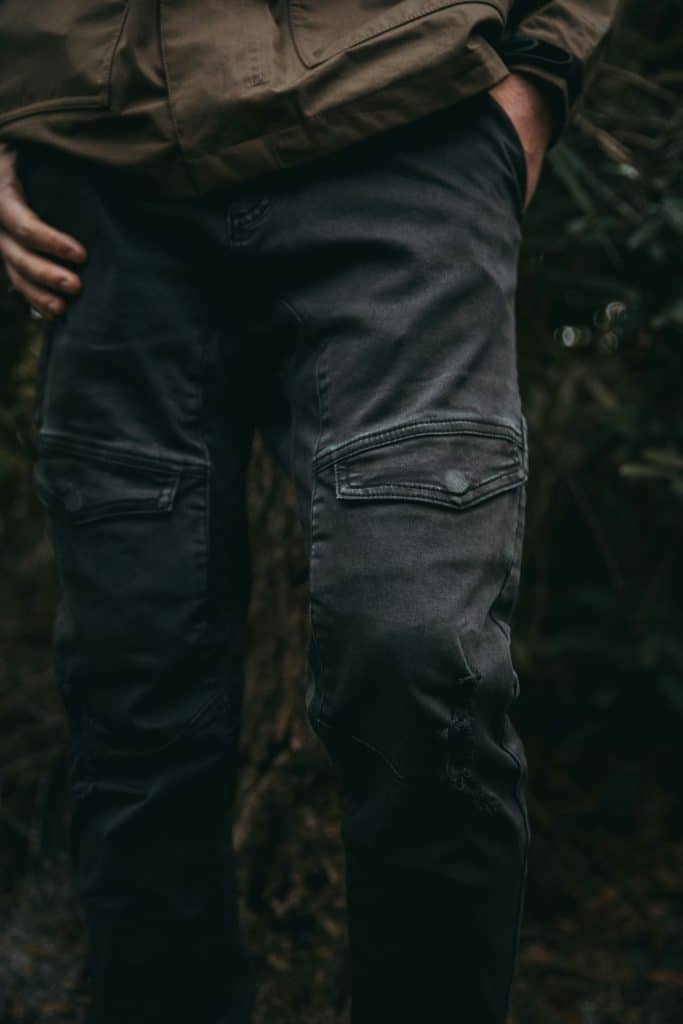
FAQs – Selecting the Best Hunting Pants
What materials make hunting pants quiet for stalking game?
Merino wool leads the pack for quiet hunting fabrics. The SITKA Intercept pants use ArmorSpun merino that stays naturally quiet even when brushing against vegetation. Soft synthetics can also work well, but avoid anything with a hard finish or tightly woven synthetic materials that create noise.
Bonded fabrics tend to be quieter than laminated constructions, and brushed finishes typically perform better than smooth surfaces. The key is testing how the fabric sounds when it rubs against itself or catches on branches — some materials that feel soft still create noise in real hunting situations.
Are waterproof hunting pants too noisy?
Traditional waterproof fabrics can be noisy, but newer technologies have improved significantly. The KUIU Chugach pants use advanced membrane construction that stays relatively quiet while providing real waterproof protection. The trade-off is that truly waterproof pants will never be as quiet as soft shell or merino options.
For bow hunting situations, I often prefer water-resistant pants with DWR coatings rather than fully waterproof options, accepting some compromise in weather protection for better stealth performance.
How many layers underneath should you wear in winter?
This depends on your activity level and the specific conditions. For active hunting, a merino base layer under insulated pants like the Stone Glacier De Havilland usually provides enough warmth down to about 20 degrees. For stationary hunting in extreme cold, you might need both base layers and mid-layers.
The key is avoiding cotton next to your skin and having layers you can adjust as conditions change. Pants with adjustable waist systems like the Stone Glacier design accommodate different layering combinations without compromising fit.
Can you convert brush pants into rain pants over time?
No, you can’t meaningfully convert regular hunting pants into waterproof pants. DWR treatments can be reapplied to restore water resistance, but this won’t make pants truly waterproof. If you need waterproof protection, it’s better to invest in purpose-built rain pants like the KUIU Chugach rather than trying to upgrade regular pants.
How should I repair a tear in reinforced knees?
Small tears in reinforced areas can often be repaired with fabric patches and seam sealers designed for technical fabrics. For pants like the Born Primitive with ballistic nylon reinforcements, you’ll need heavy-duty patches that match the material properties. Large tears usually mean it’s time for replacement, especially if the tear compromises the reinforcement system.
Final Thoughts
The best hunting pants won’t make you a better hunter, but the wrong pants can definitely make you a worse one. I’ve been in situations where uncomfortable, noisy, or inadequate pants directly contributed to blown opportunities — and I’ve had other hunts where the right gear made all the difference.
The pants I’ve recommended here have all earned their spots through real-world performance. Some are longtime favorites that have proven themselves over multiple seasons, while others are newer designs that impressed me immediately and continued to perform when it mattered most.
Your specific needs will determine which pants work best for you. Consider your primary hunting style, typical weather conditions, and the terrain you hunt most often. A serious late-season whitetail hunter has different needs than someone who primarily bow hunts in September, and your pants should reflect those differences.
Remember that quality hunting pants are a long-term investment. Taking care of them properly — following washing instructions, reapplying DWR treatments when needed, and making minor repairs promptly — will extend their useful life significantly. When you find pants that work for your hunting style, stick with them. There’s something to be said for gear you trust completely when that shot opportunity finally presents itself.
Per our affiliate disclosure, we may earn revenue from the products available on this page. To learn more about how we test gear, click here.



